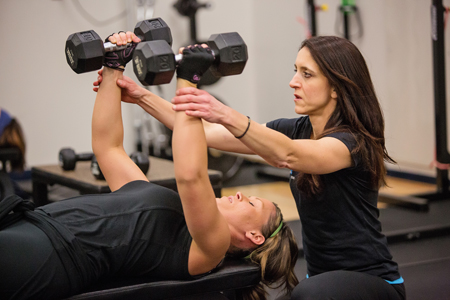It’s Friday morning. You arrive at the gym, pull out your workout and review what’s in store for today’s group strength class. Surprise! You have an extra set of bench presses and the weight on your leg press went up. Some of your rest intervals are even shorter!
What’s the deal here? You were finally getting comfortable, and now we went ahead and made things a bit more difficult — again?!
Well, believe it or not, there is a logical reason behind these changes, and they all are based on perhaps the most important principle of strength training: progressive overload.
What is Progressive Overload & Why is it Important?
Progressive overload is the act of intentionally and continually increasing the stress placed on the body during exercise. This increase should correspond to the body’s improved exercise capacity as it adapts to the previous level of stress. If exercise intensity is not increased to a level slightly above what the body is accustomed to, desirable adaptations relating to body composition, strength, and performance will no longer occur.
Overload is not always attained through increasing weight — increasing the number of repetitions or sets performed, decreasing the rest between sets, or adding another day of exercise are a few additional ways overload is commonly achieved.
Application to Class
Say you start out using 20 lb dumbbells for your bench presses with a repetition goal of 8 to 10.
Week 1 you get 10 reps on your first two sets, and 9 on your third set. This is good! You are right in the repetition range that we gave you!
On week 2 you are able to get all 10 reps, for all 3 sets — nice improvement there!
Week 3 comes along, and you notice that you have a 4th set of the exercise, and your rest interval is reduced from 75 seconds to 60 seconds. The weight remains unchanged, but overload nonetheless is being achieved due to the added set and reduced rest. You are a bit nervous, but prove to be up for the challenge, once again getting all 10 reps, even on the 4th set.
Fast forward to week 4, you are now given 22.5 lb dumbbells, up from the 20 lbs that you had been using. You are able to get all 10 reps on the first two sets, but only 9 on set three, and 8 on set four.
This is where many people go wrong. There is no need to be discouraged by the fact that you are no longer able to hit the top end of your rep range for all of your sets! We give you a range of repetitions for a reason. As long as you are able to stay within the range, the weight likely is appropriate. In fact, sometimes the only way to get stronger or build more lean mass is to increase the weight a little bit, see a corresponding reduction in repetitions, and then work your way back up to the top of the rep range.
From here, it is a “rinse-and-repeat” strategy.
Take Home Message
Progressive overload is the practice of gradually increasing exercise stress beyond what the body has already adapted to. While this tenet of strength training may sound more like a form of cruel and unusual punishment, gradually overloading your body is vital to seeing continued improvements in strength, performance, or body composition.
Disclaimer
There are MANY factors that contribute to how progressive overload should be implemented for each individual.
Genetics, exercise experience, age, orthopedic issues, and a multitude of other factors all play a role in how fast and in what manner progressive overload should be implemented. While anyone is capable of improving their fitness, increasing strength, or further improving body composition, no two people will follow the same path or move at the same pace.
Form should not be compromised in the name of progressive overload.
About the Author:
-

Michael Stack is the founder & CEO of Applied Fitness Solutions and Frontline Fitness Pros. He is a faculty lecturer for the University of Michigan’s School of Kinesiology. He is also the creator and the host of the Wellness Paradox Podcast, produced in conjunction with University of Michigan.
Michael is an exercise physiologist by training and a health entrepreneur, health educator, and fitness industry advocate by trade. He is dedicated to enhancing the standard of practice of, and advocating for, fitness and wellness professionals to ensure they become an essential constituent in the healthcare delivery system.
With a career spanning over three decades in fitness, health, and wellness Michael has a deep knowledge of exercise physiology, health/wellness coaching, lifestyle interventions to mitigate chronic disease and leadership. He is credentialed through the American College of Sports Medicine (ACSM) as an Exercise Physiologist (ACSM-EP), Exercise is Medicine practitioner (ASCM-EIM), and a Physical Activity in Public Health Specialist (ACSM-PAPHS). Michael is a National Strength & Conditioning Association (NSCA) Certified Strength & Conditioning Specialist (CSCS), and a CDC Diabetes Prevention Program (DPP) Lifestyle Coach.
Michael received his undergraduate degree from the University of Michigan’s School of Kinesiology in 2004 and is currently a Master’s of Public Health (MPH) candidate at University of Michigan, with a specific concentration in health behavior and health education.
Michael is a board of directors’ member for the Physical Activity Alliance and Michigan Fitness Clubs Association. He sits on the University of Michigan’s School of Kinesiology Alumni Board of Governors. Michael is an expert curriculum reviewer for the American College of Lifestyle Medicine. Finally, he is a member of the executive leadership team for American Heart Association’s Heart Walk.
Michael lectures nationally for several health/fitness certification and continuing educations, including; IHRSA, the Medical Fitness Association, the National Strength & Conditioning Association, and SCW Fitness.

